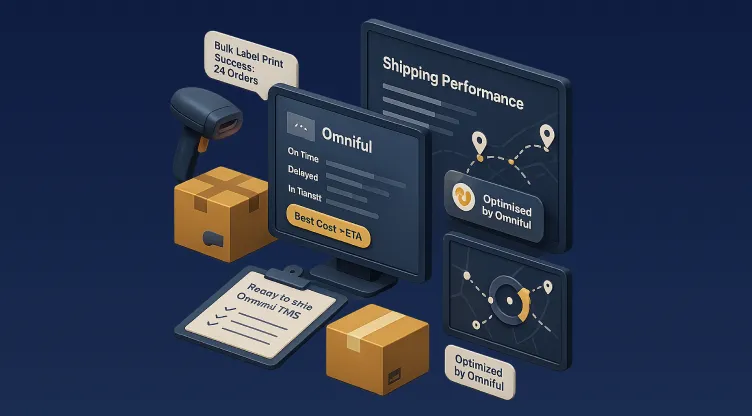Speed, Accuracy, and Savings in One Shipping Stack
Optimising warehouse shipping is critical to improving fulfilment speed, reducing costs, and enhancing customer satisfaction. This guide walks through best practices including:
- Smart warehouse layout organisation
- Use of Warehouse Management Systems (WMS)
- Automation of packing, labelling, and documentation
- Real-time inventory tracking
- Strong coordination between warehouse teams and carriers
- Strategic shipping method and carrier selection
- Leveraging predictive analytics and AI
- Monitoring key performance indicators (KPIs)
Together, these strategies modernise your operations and drive warehouse logistics efficiency, especially for retailers and 3PL providers in competitive markets like the MENA region.
Best Practices for Optimising Warehouse Shipping
Efficient warehouse shipping operations ensure uninterrupted order processing and shipping activities. By adopting best practices, businesses can optimise the warehouse shipping process, reduce costs, and improve overall warehouse logistics optimisation. Below are key strategies to enhance efficiency and accuracy in warehouse shipping.
Organising Warehouse Layout for Streamlined Workflows
A well-organised warehouse layout is the foundation of an optimised warehouse shipping process. Workflow operations will run smoothly when efficient organisation prevents bottlenecks & accelerates item retrieval.
Best Practices:
-
The closer regularly ordered items are to packing stations, the faster order processing & shipping operations become.
-
Establish separate storage areas for each product type and use clear signs to guide movement within the space.
-
Implement dynamic slotting to adjust storage locations based on seasonal demand patterns.
Organising the warehouse layout effectively allows businesses to streamline operations and optimise warehouse logistics.
Implementing a Warehouse Management System (WMS)
A Warehouse Management System (WMS) is a powerful tool for managing the warehouse shipping process. The system automates essential operations and enhances inventory tracking capabilities, ensuring uninterrupted coordination between all organisational departments.
Best Practices:
-
WMS real-time inventory tracking reduces stock discrepancies.
-
Automated order processing systems eliminate human errors during each phase of order processing & shipping.
-
Integrating carrier systems into your WMS enables access to live shipment tracking capabilities.
Implementing Warehouse Management Systems (WMS) leads to superior shipping operations through improved accuracy and higher productivity levels.
Automating Packing, Labelling, and Documentation
Implementing warehouse automation systems leads to faster shipping times and reduces operational mistakes.
Best Practices:
-
Automated packing machines ensure items remain protected by utilising packaging solutions designed to match item size & fragility properties.
-
Implement label-generating software programs to produce accurate barcodes while adding shipping details.
-
Digitise documentation processes to eliminate paperwork delays.
Automation speeds up order completion and shipment while simultaneously enhancing warehouse logistics operations.
Utilising Real-Time Inventory Tracking Solutions
Real-time inventory tracking is crucial for maintaining accurate stock levels and preventing delays in the warehouse shipping process. Advanced tracking solutions allow businesses to monitor their inventory movement across the supply chain.
Best Practices:
-
The combination of RFID technology and barcode scanners provides businesses with up-to-the-minute updates on inventory modifications.
-
Businesses should implement predictive analytics tools to assess future demand scenarios, which will help create effective inventory replenishment plans.
-
Warehouse management systems working alongside tracking systems enable seamless data exchange.
Real-time inventory tracking streamlines order fulfilment and shipping operations by removing delays caused by stock shortages.
Enhancing Communication Between Warehouse Teams and Carriers
Warehouse operations achieve timely shipments through essential communication between warehouse teams and carriers. Effective collaboration between operations teams leads to reduced delays and enhanced customer satisfaction.
Best Practices:
-
Teams in different organisations can communicate in real-time via cloud-based platforms.
-
Using advanced shipment schedules, carriers can successfully prevent operational disruptions.
-
Periodic reviews of carrier performance help businesses choose reliable partners for upcoming shipments.
Businesses which improve their communication channels reach peak warehouse logistics performance alongside seamless order processing and shipment execution.
Adopting best practices enables businesses to optimise warehouse shipping operations through improved shipment accuracy and speed alongside cost reduction.
Shipping Methods & Carrier Selection Strategies
Warehouse shipping operations maintain smooth operations through strategic choices of shipping methods and carriers, which ensure efficient order fulfilment and shipping processes. When businesses optimise their warehouse shipping operations, they achieve cost savings & faster delivery times and enhanced logistics performance within their warehouses. This section demonstrates critical approaches to choosing appropriate shipping methods and carriers.
Each order type requires specific shipping choices to achieve successful delivery outcomes.
Selecting shipping methods requires balancing cost-effectiveness with delivery speed to achieve customer satisfaction expectations. Organisations must develop individual delivery strategies that fit each specific order type to deliver services efficiently.
Shipping Methods:
-
Ground Shipping offers economical delivery while demanding longer transit periods.
-
Expedited Shipping delivers goods within 2 to 3 days without compromising affordability.
-
Selecting Same-Day Shipping for time-sensitive orders incurs higher shipping fees.
-
Cross-border orders require International Shipping because they must pass customs and incur additional fees.
-
Freight Shipping service applies custom transportation solutions to move goods that surpass the limitations of standard shipping regulations.
By implementing order-specific shipping methods, businesses achieve efficient fulfilment processes and profitable operations.
Negotiating Shipping Rates & Discounts
Warehouse shipping process optimisation relies on substantial shipping cost reductions as its fundamental basis. Through carrier rate negotiations, companies can secure substantial profit margin improvements.
Strategies:
-
Study your shipping metrics for volume weight and destination details to build a compelling negotiation strategy.
-
Develop partnerships with various carriers to analyse their pricing models so you can secure improved discount agreements.
-
Utilise your expected shipment volume increases to secure better carrier discount rates.
Effective negotiation with shipping carriers leads to cost savings and enhanced warehouse operations by building stronger relationships with carriers.
Tracking and Evaluating Carrier Performance
Businesses must continuously track carrier performance to maintain dependable deliveries and customer satisfaction. Essential performance metrics tracking helps businesses pinpoint potential improvement areas.
Performance Metrics:
-
This performance indicator measures the rate at which carriers achieve delivery deadlines.
-
Assess how quickly carriers update customers when delivery issues or delays occur.
-
Identify cases of carrier failure to meet commitments, which lead to increased expenses.
Assessing carrier performance in warehouse operations enables more effective choices for order fulfilment and shipping processes.
Through these strategies, businesses achieve warehouse shipping process simplification, and both enhance customer satisfaction and reduce logistics operation costs.
The Role of Technology in Warehouse Shipping
Technology has revolutionised warehouse shipping, transforming the warehouse shipping process into a streamlined, efficient, and highly accurate operation. By integrating innovative solutions such as automation, RFID, barcode scanning, and predictive analytics, businesses can optimise order fulfilment and shipping while achieving superior warehouse logistics optimisation.
Benefits of Warehouse Automation and AI-Driven Logistics
Warehouse automation and AI-driven logistics are key technologies that enhance efficiency in the warehouse shipping process. Automation minimises manual labour, reduces errors, and accelerates operations across picking packing, and shipping tasks. AI-powered systems optimise workflows by analysing data to improve inventory management and demand forecasting.
Key Benefits:
-
Order fulfilment operations and shipping activities achieve better results with faster processing times and improved accuracy.
-
Implementing automated picking and packing systems enables businesses to reduce their labour expenses.
-
Warehouse logistics operations reach optimal performance when AI insights improve inventory management practices.
How RFID and Barcode Scanning Improve Accuracy
RFID and barcode scanning technologies are essential tools that significantly enhance the accuracy of warehouse shipping processes. Automated inventory tracking systems eliminate human errors and provide real-time visibility of stock levels.
Advantages:
-
RFID technology provides quicker tracking of inventory movements than traditional tracking systems.
-
Implementing barcode scanning technology maintains accurate order labelling during fulfilment and shipping operations.
-
These technologies improve traceability, which enables warehouse logistics operations to be optimised without any disruptions.
Using Predictive Analytics for Demand-Based Shipping Planning
AI technology provides predictive analytics tools to examine historical data & predict demand patterns, which enhances business shipping operations from warehouses. Through its operational processes, the system achieves efficient resource management and cost reduction by eliminating both excess inventory & stock shortages.
Applications:
-
Businesses achieve higher market adaptability by predicting peak demand patterns with accuracy.
-
Advanced decision-making techniques in inventory management systems create better order fulfilment while upgrading shipping ops.
-
Enhanced supply chain resilience through proactive planning.
Key Performance Indicators (KPIs) for Shipping Optimisation
To improve warehouse shipping operations, businesses must measure KPIs to understand efficiency and identify enhancement opportunities. Warehouse logistics optimisation allows businesses to improve order fulfilment and shipping by monitoring order accuracy, delivery times, customer satisfaction, and shipping costs. These KPI measurements yield essential data that enables warehouse shipping operations to achieve their goals alongside meeting customer requirements.
Order Accuracy Rate and Error Reduction
The order accuracy rate represents how often shipments arrive error-free to customers. When warehouses reduce mistakes during shipping, they boost customer contentment and lower costs from returns.
On-Time Delivery and Shipping Lead Time
On-time delivery assesses the percentage of orders delivered on schedule, while shipping lead time measures the duration from order placement to dispatch. Managers must monitor all relevant metrics to reach complete efficiency in order fulfilment and shipping operations.
Cost Per Shipment and Overall Efficiency Metrics
Performance evaluation of warehouse shipping based on shipment price analysis through productivity measurements reveals potential cost savings.
Customer Satisfaction and Return Management
The warehouse shipping performance evaluation through customer satisfaction assessments measures effectiveness against customer expectations, while return management efficiency guarantees the correct processing of returned goods.
Optimised KPIs enable organisations to enhance warehouse logistics systems, which leads to improved operational efficiency and better services.
Conclusion
Businesses in today’s logistics industry must optimise warehouse shipping to reach operational excellence and deliver outstanding customer satisfaction. Advanced tools, including automation and predictive analytics, allow businesses to streamline warehouse shipping processes while ensuring efficient order fulfilment through real-time tracking. Modern warehouse requirements benefit from platforms such as Omniful which deliver innovative solutions that create seamless workflows and advanced logistics optimisation.
FAQs
What are the main warehouse shipping challenges?
Main warehouse shipping challenges include shipping cost inefficiencies, inefficient layout, and inventory discrepancies, which optimisation strategies and technology integration can resolve.
What technological developments can result in improved shipping efficiency in warehousing operations?
Technology application in warehouse shipping results in improved operation processes through automation and stock management, minimised errors, and raised productivity levels.
In what ways does Omniful assist in optimisation of warehouse shipping operations?
Omniful is a central provider of cutting-edge solutions that automate warehouse operations and improve accuracy, and increase logistics efficiency based on their website www.omniful.ai
























